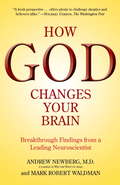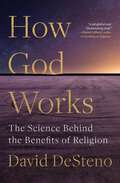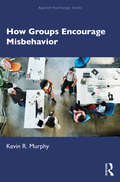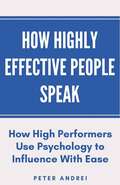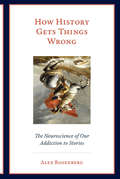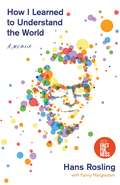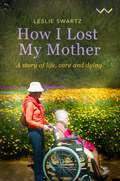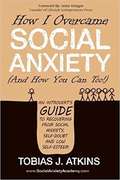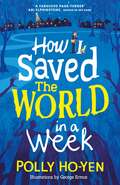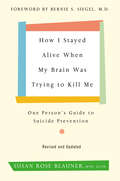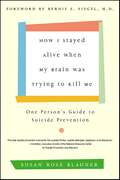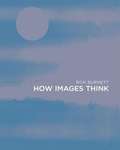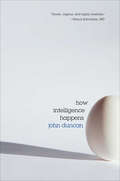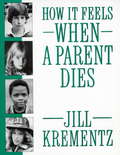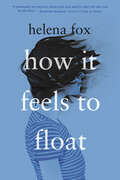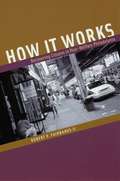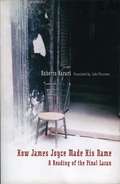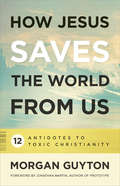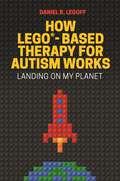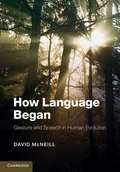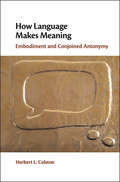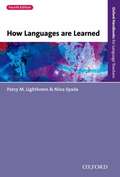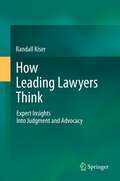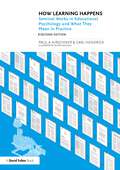- Table View
- List View
How God Changes Your Brain: Breakthrough Findings from a Leading Neuroscientist
by Andrew Newberg Mark Robert Waldman"How God Changes Your Brain" is a highly practical, easy-to-read guide on the interface between spirituality and neuroscience, filled with useful information that can make your brain and your life better. --Daniel G. Amen, M. D.
How God Works: The Science Behind the Benefits of Religion
by David DeStenoDrawing on a wealth of new evidence, pioneering research psychologist David DeSteno shows why religious practices and rituals are so beneficial to those who follow them—and to anyone, regardless of their faith (or lack thereof).Scientists are beginning to discover what believers have known for a long time: the rewards that a religious life can provide. For millennia, people have turned to priests, rabbis, imams, shamans, and others to help them deal with issues of grief and loss, birth and death, morality and meaning. In this absorbing work, DeSteno reveals how numerous religious practices from around the world improve emotional and physical well-being. With empathy and rigor, DeSteno chronicles religious rites and traditions from cradle to grave. He explains how the Japanese rituals surrounding childbirth help strengthen parental bonds with children. He describes how the Apache Sunrise Ceremony makes teenage girls better able to face the rigors of womanhood. He shows how Buddhist meditation reduces hostility and increases compassion. He demonstrates how the Jewish practice of sitting shiva comforts the bereaved. And much more. DeSteno details how belief itself enhances physical and mental health. But you don&’t need to be religious to benefit from the trove of wisdom that religion has to offer. Many items in religion&’s &“toolbox&” can help the body and mind whether or not one believes. How God Works offers advice on how to incorporate many of these practices to help all of us live more meaningful, successful, and satisfying lives.
How Good Do We Have to Be? A New Understanding of Guilt and Forgiveness
by Harold S. KushnerHere is the introduction to the book: INTRODUCTION I HAVE BEEN THINKING about the ideas expressed in this book for a long time. Even as a child, I was bothered by the biblical story of the Garden of Eden. A God who punished people so severely for breaking one arbitrary rule was not a God I wanted to believe in, especially since the story seemed to suggest that Adam and Eve had no knowledge of what good and bad meant before they broke the rule. As I grew older, I encountered so many instances of people doing what they thought God had done in the Bible, rejecting someone for making one mistake, for not being perfect. When I was rabbi of a congregation in suburban Boston and members of my synagogue would share their problems with me, I would repeatedly hear of children angry at their parents, parents disappointed in their children, husbands and wives upset with each other, brothers not inviting brothers to a wedding because of an argument that had taken place years earlier. The pattern tended to be the same: somebody did something wrong and someone else responded by withdrawing love, sometimes by withdrawing all contact. And the retaliator felt justified in doing that because, after all, hadn't God done the same thing in the Garden of Eden? I often felt frustrated at the inability of my religious perspective to heal that breach. Fifteen years ago, responding to a personal tragedy, I wrote a book called When Bad Things Happen to Good People. Its message was simple but radical: when something bad happens to you, it is not a case of God punishing you because you deserve it. God is on your side, not on the side of the illness or the injury. This book can be seen as an extension of that earlier one. Its message is equally simple and equally radical: God does not stop loving us every time we do something wrong, and neither should we stop loving ourselves and each other for being less than perfect. If religious teachers tell us otherwise, that is bad religion. If our parents responded to our misbehavior by withdrawing their love, that was a bad response by people who may otherwise have been good parents. I hope that our sense of self-worth, our relationships to our parents, our children, our mates, our siblings, and friends will improve once we learn the lesson that one mistake need not lead to rejection and banishment. And I hope that this book will guide you to gaining that blessing.
How Groups Encourage Misbehavior (Applied Psychology Series)
by Kevin R MurphyHow Groups Encourage Misbehavior explores the psychological and social processes by which groups develop a tolerance for and even encourage misbehavior. Drawing from decades of research on social, cognitive and organizational psychology, as well as a deep well of historical research, this book shows how commitment to groups, organizations and movements can turn moral individuals into amoral agents. Pulling together what have been traditionally distinct areas of study, How Groups Encourage Misbehavior provides a detailed and unified account of how good organizations go bad and how groups of all types can push otherwise honest and upright individuals to behave in ways that violate laws and social norms. This text describes how social norms, rationalization, the characteristics of formal and informal groups, attachment to groups and organizations, and the structure of organizational life can all contribute to misbehavior. Each chapter includes one or more sidebar discussions of relevant and interesting examples to illustrate the ways groups and organizations encourage and support misbehavior. The final two chapters discuss how many of these same attributes and processes can be used to encourage positive behaviors and foster recovery from dysfunctional and corrupt cultures and modes of behavior. A valuable text for a broad range of psychology courses, How Groups Encourage Misbehavior will especially appeal to practitioners, scholars, and students interested in ethics in organizations and the intersection between social psychology and organizational behavior.
How Highly Effective People Speak: How High Performers Use Psychology To Influence With Ease (Speak For Success Ser.)
by Peter AndreiIn How Highly Effective People Speak, you'll discover 194 communication habits of highly effective people (proven by 57 scientific studies) including: How to get more done with less effort by influencing others to support you How to attract others (instead of turning them away and seeming unfriendly) with the correct type of body language How to make people systematically, predictably, and reliably overweigh your opinion by activating the availability bias How to charge more or pay less (for the same product) and win every negotiation with the anchoring effect How to effortlessly make others want something by activating one little-known cognitive bias (called "essential" by billionaire investor Charlie Munger, partner to Warren Buffet) How to lead with ease and reliably influence teams by using the contrast effect How to effortlessly speak with memorable eloquence by applying 2,000-year-old secrets of powerful language How to ace every interview, meeting, and presentation with ease by activating agent detection bias How to quickly diffuse all objections by activating the little-known (but extremely powerful) zero-risk bias How to make people believe something even if they think the exact opposite with the illusory truth effect How to appear authoritative, trustworthy, and capable in 10 seconds by activating the halo effect How to combine the science of psychology with the art of communication and create a critical competitive advantage in life
How History Gets Things Wrong: The Neuroscience of Our Addiction to Stories (The\mit Press Ser.)
by Alex RosenbergWhy we learn the wrong things from narrative history, and how our love for stories is hard-wired.To understand something, you need to know its history. Right? Wrong, says Alex Rosenberg in How History Gets Things Wrong. Feeling especially well-informed after reading a book of popular history on the best-seller list? Don't. Narrative history is always, always wrong. It's not just incomplete or inaccurate but deeply wrong, as wrong as Ptolemaic astronomy. We no longer believe that the earth is the center of the universe. Why do we still believe in historical narrative? Our attachment to history as a vehicle for understanding has a long Darwinian pedigree and a genetic basis. Our love of stories is hard-wired. Neuroscience reveals that human evolution shaped a tool useful for survival into a defective theory of human nature. Stories historians tell, Rosenberg continues, are not only wrong but harmful. Israel and Palestine, for example, have dueling narratives of dispossession that prevent one side from compromising with the other. Henry Kissinger applied lessons drawn from the Congress of Vienna to American foreign policy with disastrous results. Human evolution improved primate mind reading—the ability to anticipate the behavior of others, whether predators, prey, or cooperators—to get us to the top of the African food chain. Now, however, this hard-wired capacity makes us think we can understand history—what the Kaiser was thinking in 1914, why Hitler declared war on the United States—by uncovering the narratives of what happened and why. In fact, Rosenberg argues, we will only understand history if we don't make it into a story.
How I Learned to Understand the World: A Memoir
by Hans RoslingThe moving, playful memoir of Hans Rosling, Swedish statistics mastermind, researcher extraordinaire and author of the global bestseller, Factfulness, with Ola Rosling and Anna Rosling RönnlundThis is a book that contains very few numbers. Instead, it is about meeting people who have opened my eyes.It was facts that helped him explain how the world works. But it was curiosity and commitment that made the late Hans Rosling, author of the bestselling book Factfulness with Ola Rosling and Anna Rosling Rönnlund, the most popular researcher of our time. How I Learned to Understand the World is Hans Rosling’s own story of how he became a revolutionary thinker, and takes us from the swelter of an emergency clinic in Mozambique, to the World Economic Forum at Davos. In collaboration with Swedish journalist Fanny Härgestam, Hans Rosling wrote his memoir with the same joy of storytelling that made a whole world listen when he spoke.
How I Lost My Mother: A story of life, care and dying
by Leslie SwartzHow I Lost My Mother is a deeply felt account of the relationship between a mother and son, and an exploration of what care for the dying means in contemporary societyThe book is emotionally complex – funny, sad and angry – but above all, heartfelt and honest. It speaks boldly of challenges faced by all of us, challenges which are often not spoken about and hidden, but which deserve urgent attention. This is first and foremost a work of the heart, a reflection on what relationships mean and should mean. There is much in the book about relationships of care and exploitation in southern Africa, and about white Jewish identity in an African context. But despite the specific and absorbing references to places and contexts, the book offers a broader, more universal view. All parents of adult children, and all adults who have parents alive, or have lost their parents, will find much in this book to make them laugh, cry, think and feel.
How I Overcame Social Anxiety (And How You Can Too!): An Introverts Guide to Recovering from Social Anxiety, Self-Doubt and Low Self-Esteem
by Tobias J. Atkins<p>Do you get nervous in public and don’t know why? Do you find it hard to relax and be yourself around people? Do you constantly worry what everyone thinks of you? Are you tired of always feeling inferior and ‘less than’ others? Wish you could turn off that critical voice inside your head? Perhaps you feel you were ‘born that way’ and things will never change? <p>This book documents my 15 year struggle with social anxiety; the contributing factors and the exact steps I took to find my healing. In these pages, you’ll discover: <p> <li>The real causes behind your social anxiety & shyness (it’s not what you think) <li>The exact steps I took to overcome social anxiety (and how you can too!) <li>How to stop fearing the opinions and judgments of others <li>How to let go of perfectionism and always putting yourself down <li>What I learned from spending over $35,000 on alternative therapies <li>Techniques to release anxiety and self-consciousness in minutes, not years</li> </p>
How I Saved the World in a Week
by Polly Ho-YenA brilliantly imagined new 8+ adventure about resilience, family and hope. From the bestselling and Waterstones Children&’s Book Prize shortlisted author of BOY IN THE TOWER. Perfect for fans of Ross Welford, Lisa Thompson and Onjali Rauf.Rule number one: Always be prepared . . . Billy&’s mum isn&’t like other mums. All she wants is to teach him the Rules of Survival – how to make fire, build shelter and find food. She likes to test Billy on the rules until one day she goes too far, and Billy is sent to live with a dad he barely knows. Then the world changes forever as people begin to be infected with a mysterious virus that turns their skin grey. As chaos breaks out, Billy has to flee the city. Suddenly he realises that this is what his mum was preparing him for – not just to save his family, but to save the whole world. Praise for How I Saved the World in a Week: &‘A fabulous page-turner&’ – Abi Elphinstone, author of Sky Song &‘A compelling and timely survivalist journey&’ – Sita Brahmachari, author of Where the River Runs Gold &‘A brave and powerful story&’ – Jasbinder Bilan, author of Asha & the Spirit BirdPraise for Boy in the Tower: &‘An unusual and very impressive debut&’ – Fiona Noble, The Bookseller
How I Stayed Alive When My Brain Was Trying to Kill Me, Revised Edition: One Person's Guide to Suicide Prevention
by Susan Rose BlaunerNOW WITH A NEW CHAPTER AND AN UPDATED RESOURCES SECTIONSuicide has touched the lives of nearly half of all Americans, yet it is rarely talked about openly. In her highly acclaimed book, Susan Blauner—a survivor of multiple suicide attempts—offers guidance and hope for those contemplating ending their lives and for their loved ones.“Each word written with thoughtful intent; each story told with the deepest of honesty and humility, and in doing so Blauner puts forward a life-saving book."—Daniel J. Reidenberg, PsyD, Executive Director, Suicide Awareness Voices of Education (www.save.org)“I continued to romanticize my death by suicide: who would find me; what I’d look like. I spent hundreds of hours planning my funeral, imagining the remorse of my family and friends. I wrote good-bye letters, composed wills, and disrupted the lives of everyone close to me. Then reality hit.”—Susan Rose BlaunerThe statistics on suicide are staggering. The World Health Organization estimates that nearly 800,000 people die by suicide every year, which is one person every 40 seconds, and for each completed suicide there may be twenty or more attempts.In How I Stayed Alive When My Brain Was Trying to Kill Me, Susan Blauner is the perfect emissary for a message of hope and a program of action for these millions of people. A survivor of multiple suicide attempts, she explains the complex feelings and fantasies that surround suicidal thoughts. In a direct, nonjudgmental, and loving voice, she offers affirmations and suggestions for those experiencing life-ending thoughts, and for their friends and family. With an introduction by Bernie Siegel, M.D., this important, timely book has now been updated with a revised resources section, and a new chapter on the author’s experiences since the book’s initial publication.
How I Stayed Alive When My Brain Was Trying to Kill Me: One Person's Guide to Suicide Prevention
by Susan Rose BlaunerA woman shares her eighteen-year struggle with suicidal thoughts, explains the brain functions behind those thoughts, and offers tricks to overcome them.The statistics on suicide are staggering. According to the US Center for Disease Control and Prevention, in 1997 in the United States, more teenagers and young adults died from suicide than from cancer, heart disease, AIDS, birth defects, stroke, pneumonia, influenza, and chronic lung disease combined. It is also an international epidemic.Susan Blauner is the perfect emissary for a message of hope and a program of action for these millions of people. She’s been though it, and speaks and writes eloquently about feelings and fantasies surrounding suicide.“The best suicide prevention manual for the suicidal thinker, suicide attempter, layperson, or professional.” —Iris Bolton, founder of the National Resource Center for Suicide Prevention and Aftercare“How I Stayed Alive is like a Fodor’s guide that gets you from the depths of hell of depression to the paradise of a balanced life.” —Reese Butler, executive director and founder of the National Hopeline Network“With neither hollow platitudes nor medical doublespeak . . . an extreme valuable and much needed tool for suicidal thinkers and their loved ones.” —Publishers Weekly
How Images Think
by Ron BurnettDigital images are an integral part of all media, including television, film, photography, animation, video games, data visualization, and the Internet. In the digital world, spectators become navigators wending their way through a variety of interactive experiences, and images become spaces of visualization with more and more intelligence programmed into the very fabric of communication processes. In How Images Think, Ron Burnett explores this new ecology, which has transformed the relationships humans have with the image-based technologies they have created. So much intelligence has been programmed into these image-dependent technologies that it often seems as if images are "thinking"; ascribing thought to machines redefines our relationship with them and enlarges our ideas about body and mind. Burnett argues that the development of this new, closely interdependent relationship marks a turning point in our understanding of the connections between humans and machines. After presenting an overview of visual perception, Burnett examines the interactive modes of new technologies -- including computer games, virtual reality, digital photography, and film -- and locates digital images in a historical context. He argues that virtual images occupy a "middle space," combining the virtual and the real into an environment of visualization that blurs the distinctions between subject and object -- part of a continuum of experiences generated by creative choices by viewers, the results of which cannot be attributed either to images or to participants.
How Intelligence Happens
by John DuncanA lively journey through the brain&’s inner workings from &“one of the world&’s leading cognitive neuroscientists&” (The Wall Street Journal). Human intelligence builds sprawling cities, vast cornfields, and complex microchips. It takes us from the atom to the limits of the universe. How does the biological brain, a collection of billions of cells, enable us to do things no other species can do? In this book, neuroscientist John Duncan offers an adventure story—the story of the hunt for basic principles of human intelligence, behavior, and thought. Using results drawn from classical studies of intelligence testing; from attempts to build computers that think; from studies of how minds change after brain damage; from modern discoveries of brain imaging; and from groundbreaking recent research, he synthesizes often difficult-to-understand information into clear, fascinating prose about how brains work. Moving from the foundations of psychology, artificial intelligence, and neuroscience to the most current scientific thinking, How Intelligence Happens is &“a timely, original, and highly readable contribution to our understanding&” (Nancy Kanwisher, MIT) from a winner of the Heineken Prize for Cognitive Science
How It Feels When a Parent Dies
by Jill Krementz18 children from age 7 - 17, speak openly of their experiences and feelings. As they speak we see them in photos with their surviving parent and with other family members, in the midst of their everyday lives.
How It Feels to Float
by Helena FoxA deeply hopeful YA novel about living with mental illness that's perfect for fans of Girl in Pieces"Profoundly moving . . . Will take your breath away." --Kathleen Glasgow, author of Girl in PiecesBiz knows how to float. She has her people, her posse, her mom and the twins. She has Grace. And she has her dad, who tells her about the little kid she was, and who shouldn't be here but is. So Biz doesn't tell anyone anything. Not about her dark, runaway thoughts, not about kissing Grace or noticing Jasper, the new boy. And she doesn't tell anyone about her dad. Because her dad died when she was seven. And Biz knows how to float, right there on the surface--normal okay regular fine.But after what happens on the beach--first in the ocean, and then in the sand--the tethers that hold Biz steady come undone. Dad disappears and, with him, all comfort. It might be easier, better, sweeter to float all the way away? Or maybe stay a little longer, find her father, bring him back to her. Or maybe--maybe maybe maybe--there's a third way Biz just can't see yet.Debut author Helena Fox tells a story about love and grief, about inter-generational mental illness, and how living with it is both a bridge to someone loved and lost and, also, a chasm. She explores the hard and beautiful places loss can take us, and honors those who hold us tightly when the current wants to tug us out to sea."Tackles mental health [and] sexual identity...with beauty and empathy." --Cosmopolitan.com"Mesmerizing and timely." --Bustle* "Lyrical and profoundly affecting." --Kirkus (starred review)* "Masterful...Just beautiful." --Booklist (starred review)* "Exquisite." --PW (starred review)* "Fox writes with superb understanding and tenderness." --BCCB (starred review)* "Frank [and] beautifully crafted."--BookPage (starred review)"This book will explode you into atoms." --Margo Lanagan, author of Tender Morsels"Helena Fox's novel delivers. Read it." --Cath Crowley, author of Words in Deep Blue"This is not a book; it is a work of art." --Kerry Kletter, author of The First Time She Drowned"Perfect...Readers will be deeply moved." --Books+Publishing
How It Works: Recovering Citizens In Post-Welfare Philadelphia
by Robert P. FairbanksOf the some sixty thousand vacant properties in Philadelphia, half of them are abandoned row houses. Taken as a whole, these derelict homes symbolize the city’s plight in the wake of industrial decline. But a closer look reveals a remarkable new phenomenon—street-level entrepreneurs repurposing hundreds of these empty houses as facilities for recovering addicts and alcoholics. How It Works is a compelling study of this recovery house movement and its place in the new urban order wrought by welfare reform. To find out what life is like in these recovery houses, Robert P. Fairbanks II goes inside one particular home in the Kensington neighborhood. Operating without a license and unregulated by any government office, the recovery house provides food, shelter, company, and a bracing self-help philosophy to addicts in an area saturated with drugs and devastated by poverty. From this starkly vivid close-up, Fairbanks widens his lens to reveal the intricate relationships the recovery houses have forged with public welfare, the formal drug treatment sector, criminal justice institutions, and the local government.
How James Joyce Made his Name: A Reading of the Final Lacan (Contemporary Theory)
by Roberto Harari Luke ThurstonIn this lucid and compelling analysis of Lacan's twenty-third seminar, "Le Sinthome," Roberto Harari points to new psychoanalytic pathways that lead beyond Freudian oedipal dynamics.Lacan's seminar measures the boundaries between creativity and neurosis. We learn how poetry and wordplay may offer alternatives to neurotic pain and even psychotic delusions, with Joyce as our subject.This new translation makes the intricacies of Lacan's seminar available to the English-speaking world for the first time. The author's accessible, vigorous prose explains the nuances of Lacanian theory with perfect clarity.In the extraordinary encounter between Lacan and Joyce, Harari reveals unexpected affinities between them both as theorists and writers. It illustrates how literature is the aesthetic domain that is closest to the analytic experience.
How Jesus Saves the World from Us: 12 Antidotes To Toxic Christianity
by Morgan GuytonChristianity has always been about being saved. But today what Christians need saving from most is the toxic understanding of salvation we've received through bad theology. The loudest voices in Christianity today sound exactly like the religious authorities who crucified Jesus. <p><p> This is a book for Christians who are troubled by what we've become and who want Jesus to save us from the toxic behaviors and attitudes we've embraced. Each of the 12 chapters proposes an antidote for the toxicity that has infiltrated Christian culture, such as "Worship not Performance, "Temple not Program," and "Solidarity not Sanctimony." Each chapter includes thought-provoking discussion questions, perfect for individual or group study. <p> There are many reasons to lose hope about the state of our world and our church, but Guyton offers one piece of good news: Jesus is saving the world from us, one Christian at a time.
How LEGO®-Based Therapy for Autism Works: Landing on My Planet
by Daniel B. Legoff"You know, Dr. Dan, that kid is from my planet." With in-depth descriptions of LEGO®-based therapy in action, this book explains how and why it helps to promote the development of social skills for children with autism spectrum disorders (ASDs) and related conditions. Written by Daniel B. LeGoff, who pioneered the approach, this book comprises a series of case histories of children who participated in LEGO® therapy. It traces the development of the evidence-based approach, shares the clinical insights gained along the way and highlights the principles which should be at the core of all effective treatment and educational strategies for children with ASDs. The case histories have real practical value for those working with children with ASDs and also help to demonstrate the subtleties of the adult facilitation role for professionals running sessions.
How Language Began
by David McneillHuman language is not the same as human speech. We use gestures and signs to communicate alongside, or instead of, speaking. Yet gestures and speech are processed in the same areas of the human brain, and the study of how both have evolved is central to research on the origins of human communication. Written by one of the pioneers of the field, this is the first book to explain how speech and gesture evolved together into a system that all humans possess. Nearly all theorizing about the origins of language either ignores gesture, views it as an add-on or supposes that language began in gesture and was later replaced by speech. David McNeill challenges the popular 'gesture-first' theory that language first emerged in a gesture-only form and proposes a groundbreaking theory of the evolution of language which explains how speech and gesture became unified.
How Language Makes Meaning: Embodiment and Conjoined Antonymy
by Herbert L. ColstonLanguage's key function is to enable human social interaction, for which people are motivated to engage by powerful brain mechanisms. This book integrates recent work on embodied simulations, traditional meaning-making processes and a myriad of semantic and other meaning contributors to formulate a new model of how language functions following a pattern of conjoined antonymy. It investigates how embodied simulations,semantic information, deviation, omission, indirectness, figurativity, language play, and other processes leverage rich meaning from only a few words by using inherently biological, cognitive and social frameworks. The interaction of these meaning-making components of language is described and a language-functioning model based on recent neuroscientific research is laid out to allow for a more complete understanding of how language operates.
How Languages Are Learned (Fourth Edition)
by Patsy M. Lightbown Nina SpadaWritten by experienced teacher trainers and language learning experts, Patsy Lightbown and Nina Spada, How Languages Are Learned relates the theories of first and second language acquisition to what actually goes on in the classroom. It uses activities to explore the practical implications of the ideas presented. Evaluations and case studies are included throughout the book so that you can see a practical context for the research ideas you are reading about. Many of these examples are taken directly from real second language classrooms. Now in its 4th edition, How Languages Are Learned is highly valued for the way it relates language acquisition theory to classroom teaching and learning and draws practical implications from research for the language classroom. It is widely used as a reference book on teacher training courses, and is for new and experienced practising teachers. New to this editionUpdated to reflect the most recent research in the field of second language teaching and learning Activities and Questions for Reflection personalise content and support critical thinkingExtra activities, study questions and videos available onlineNow also available as an ebook from Amazon, Kobo and iBookstore
How Leading Lawyers Think
by Randall KiserIn this book, 78 leading attorneys in California and New York describe how they evaluate, negotiate and resolve litigation cases. Selected for their demonstrated skill in predicting trial outcomes and knowing when cases should be settled or taken to trial, these attorneys identify the key factors in case evaluation and share successful strategies in pre-trial discovery, negotiation, mediation, and trials. Integrating law and psychology, the book shows how skilled attorneys mentally frame cases, understand jurors' perspectives, develop persuasive themes and arguments and achieve exceptional results for clients.
How Learning Happens: Seminal Works in Educational Psychology and What They Mean in Practice
by Carl Hendrick Paul A. KirschnerHow Learning Happens introduces 32 giants of educational research and their findings on how we learn and what we need to know to learn effectively, efficiently, and enjoyably. Many of these works have inspired researchers and teachers all around the world and have left a mark on how we teach today.Now updated to include a new section on Memory and Cognition with five new chapters, this revised second edition explores a selection of the key works on learning and teaching, chosen from the fields of educational psychology and cognitive psychology. It offers a roadmap of the most important discoveries in the way learning happens, with each chapter examining a different work and explaining its significance before describing the research, its implications for practice, and how it can be used in the classroom – including the key takeaways for teachers.Clearly divided into seven sections, the book covers: Memory and cognition How the brain works Prerequisites for learning How learning can be supported Teacher activities Learning in context Cautionary tales Written by two leading experts and illustrated by Oliver Caviglioli, this is essential reading for teachers wanting to fully engage with and understand educational research as well as undergraduate students in the fields of education, educational psychology, and the learning sciences.
